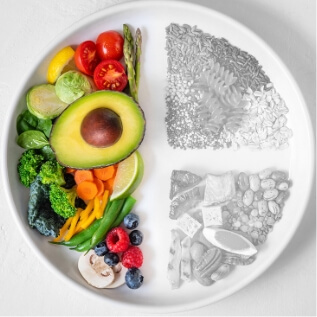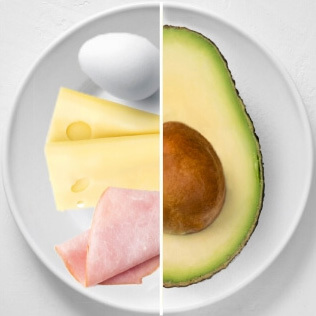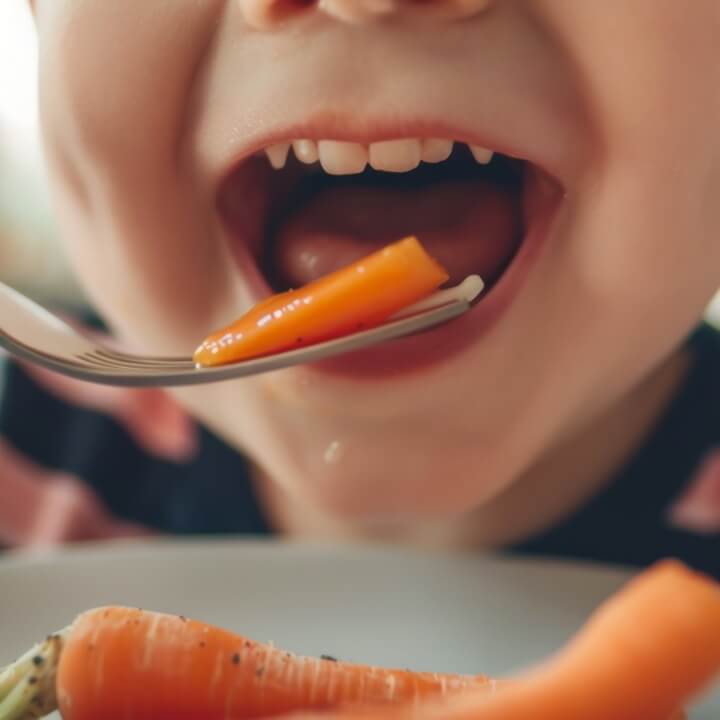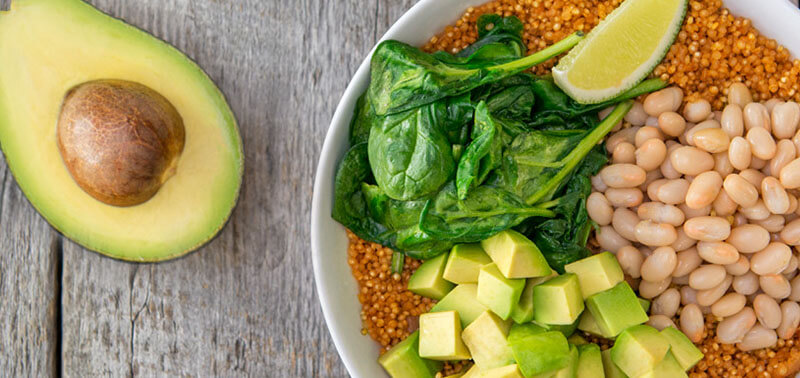To model healthy eating for children, parents and caregivers should lead by example, foster a positive food environment, and involve kids in mealtime routines. Children learn best through observation, so demonstrating nutritious choices, balanced meals, and a healthy relationship with food is key.
- Lead by example: Show kids what healthy eating looks like by eating a balanced diet yourself.
- Use positive language: Avoid labeling foods as “bad” or using food as a reward or punishment.
- Make mealtime mindful: Minimize distractions and encourage slow, enjoyable meals together.
- Introduce variety early: Offer a wide range of fruits, vegetables, and whole foods regularly.
- Empower independence: Make nutritious snacks accessible and involve kids in meal prep.
- Avoid restriction: Teach moderation instead of banning certain foods, which can lead to overindulgence.
- Stick to routines: Establish consistent meal and snack times to reduce anxiety around food.
- Support picky eaters with patience: Pair familiar favorites with new foods and avoid pressure.
- Encourage body awareness: Teach kids to recognize hunger and fullness cues.
Since avocados are so versatile, you can incorporate them into practically every meal. As you follow recipes that ask for different amounts of avocado, consider the amount you’re eating in each portion to meet your nutritional needs.
How To Model Great Eating Habits for Your Children
As a parent or caregiver, you’re already one of your child’s most powerful teachers — and that influence extends to the dinner table. Long before kids can read nutrition labels or understand food groups, they pick up cues from the adults around them. What you eat, how you talk about food, and the atmosphere you create during meals all shape how your child views nutrition, health, and even their own body. For many, this is a huge responsibility, with plenty of stakes.
Childhood obesity is on the rise. Over 20% of kids 6-11 years old and 22% of young adults 12-19 years old are considered obese in the U.S. Researchers estimate that one of the primary causes of childhood obesity is poor eating habits. With this in mind, many parents strive to guide their children toward healthy eating habits. However, without proper knowledge, nutritional education can unintentionally foster an unhealthy relationship with food or even contribute to disordered eating. In a 2023 meta-analysis that included 63,181 participants six to 18 years old, 22% reported an eating disorder. It’s a significant issue among young people with severe consequences.
Over time, people with eating disorders may develop health conditions like obesity, cardiovascular problems, and even organ failure.
While obesity, eating disorders, and unhealthy relationships with food can develop for all sorts of reasons, you can help your kids get off to a good start by teaching them what good eating habits are. For kids, the best way to do this is by modeling healthy eating habits. Because healthy habits don’t start with rules — they start with role models.
Because healthy habits don’t start with rules — they start with role models.
Why Modeling Matters in Childhood Nutrition
Many people may be familiar with modeling, even if they don’t know about the theory. For millennia, generations of parents taught their children concepts by first demonstrating them. It wasn’t until Albert Bandura labeled the concept as social learning theory in 1977 that we started exploring the idea further. He and other social psychologists theorized that most people learn by observing and imitating the actions and emotions of others around them. This theory is a lifelong process, but it is especially prevalent among parents and children during early human development. You can apply this theory to various situations and behaviors, including how we act around food. In one study, researchers found a strong correlation between children’s eating habits and their parents’.
One of the key tenets in social learning theory is modeling — the act of imitating others. At the dinner table, modeling good eating habits like eating together as a family, filling your plate with nutrient-dense foods, and trying new foods can ensure your kids will continue the practice long into adulthood.
Remember, modeling healthy habits isn’t a one-time effort—it’s an ongoing journey. As you practice these behaviors alongside your kids, you’ll be building lasting habits together. Over time, you may be surprised at how these small, consistent choices can inspire your whole family to thrive and enjoy the benefits of a healthier lifestyle.
Tips for Modeling Healthy Eating with Your Kids
If you’re unsure of where to start initiating healthy eating habits and modeling, check out these tips:
01
Educate Yourself
Before you can model good eating habits for your children, it’s essential to understand what those habits actually look like. That doesn’t mean you need a degree in nutrition, but having a basic grasp of food groups, portion sizes, how to read a nutrition facts label, and how different foods support your child’s growth and energy can make a big difference.

However, with the plethora of nutritional misinformation that exists online due to fad diets, you don’t want to start modeling behaviors that could cause nutritional deficiencies later in life.
Instead, learn the fundamentals of balanced meals like:

Nearly half of your plate should include fruits and vegetables.

A quarter of your plate should be whole grains.

Protein sources should make up a quarter of your plate.

Replace foods with saturated fats with foods with healthy unsaturated fats like avocados.
Basing all of your family’s meals on this information can set your family up for success. In addition, don’t forget to encourage your kids to stay hydrated and drink plenty of water.
If you’re unsure about the portion size your child needs for healthy development, consult your physician. They’ll be able to provide an estimate based on your child’s BMI, health history, and metabolism.
You should also research what nutrients your kids need for healthy development. If you’re unsure what foods to pick for your kids when making meals, ask yourself: What key nutrients are in this food, and why are they critical to my child’s development? For example, avocados provide 125 mg of potassium (4% DV) per 25 g serving, and potassium supports muscle development and body growth. Knowing this allows you to confidently explain the importance of foods like avocados when your kids ask “why.”
As a general rule, focus on whole, minimally processed foods and limit highly processed snacks, which often lack the essential nutrients kids need to thrive.


02
Teach About Food in a Positive, Informative Way
Labeling foods as “bad” or “junk” may seem harmless, but it can stick with your kids years later, becoming an internal stream of consciousness that may consistently stick around in their heads when encountering these foods. However, this restriction can lead to an unhealthy relationship with food, and in some cases, may lead to harmful self – talk.
Instead, you can focus on talking about foods in a positive way. For example, rather than saying, “You don’t need that,” try: “Let’s find something with healthy fats that will give you energy for the park,” or “This food helps your brain focus for school.” Framing food in terms of function — like giving us strength, helping us grow, or keeping our hearts healthy — makes the conversation both empowering and age-appropriate.

03
Encourage Mindful Eating, Not Restriction
One of the bigger drivers behind unhealthy eating patterns is restriction. In fact, restricting foods can lead to symptoms similar to withdrawal and may compel you to overeat the indulgent treat at the next opportunity. A more balanced approach is mindful eating, or eating occasional sweet treats in moderation.
Children who see adults eating various foods without stress or guilt learn that nutrition isn’t a rigid set of dos and don’ts. Instead of aiming for perfection, choose foods that can make you and your family feel good physically and emotionally. Try encouraging your kids to listen to their bodies if they start to feel full or hungry. Honoring these feelings will help them feel more attuned to their bodies and less likely to overeat.
Consider encouraging your kids to eat their favorite treats, like desserts or birthday cakes, in moderation on special occasions. This can send the message that no single food is inherently “bad,” and that it’s okay to savor sweets and celebrations without shame. This flexibility helps prevent the all-or-nothing thinking that can lead to disordered eating patterns later in life.


04
Stock Your Kitchen Strategically
Once you teach your kids the key tenets of good eating habits, you can empower them to make their own decisions. This can start with simply grabbing a snack of their own from the pantry. You can also empower them to make good decisions by making fruits, vegetables, whole grains, and other healthy snacks easily accessible. Think pre-washed fruit, cut-up vegetables, whole grain crackers, string cheese, yogurt, and mini containers of hummus or guacamole sitting on shelves in the pantry or fridge that they can easily reach. When healthy options are front and center in your fridge or pantry, your child is more likely to reach for them without a second thought.
Also, be mindful about how you store treats and highly processed snacks. There’s no need to ban them entirely — creating a sense of restriction can even backfire — but keeping these items out of immediate view helps reduce impulsive choices and puts the focus on more nourishing foods. By normalizing healthy options and treating less-nutritious snacks as occasional parts of an overall balanced diet, you can teach your child that all foods fit without giving certain items an outsized emotional pull.

05
Involve Kids in Food Preparation
If you’re still struggling to instill positive eating habits with your kids, one of the best ways to motivate them to eat healthier foods is to involve them in the preparation process. When kids help choose recipes, plan meals, or pick out produce at the store, they develop a stronger connection to what ends up on their plate.
Start small and age-appropriate. Younger children can rinse fruits and vegetables, tear lettuce for salads, or help with other preparation methods that may be fun, like mashing avocados with a fork. Older kids can help read recipes, measure ingredients, and even take the lead on simple dishes. Even tasks like setting the table or packing their own lunch boxes offer a chance to talk about balance and variety in a positive, hands-on way.
When children feel capable and included, they’re more likely to view healthy food choices as something they choose — not something you imposed.


06
Make Mealtime an Event and Routine
The kitchen table for any mealtime is the center stage for modeling healthy eating. Start by minimizing distractions during meals — turn off the TV, put phones away, and focus on conversation. When kids see adults savoring food, eating slowly, and listening to their bodies’ hunger and fullness cues, they learn to do the same. This mindful eating supports physical and emotional health, teaching children that mealtime is about nourishment, not just consumption.
Establishing regular meal and snack times also helps reduce anxiety around food. When children know they can expect to eat at consistent intervals, they’re less likely to overeat or become fixated on snacks. On the flip side, irregular eating, such as skipping meals, can make kids feel hungrier and overindulge in their next meals, increasing the risk of disordered eating patterns over time.
Keep in mind, mealtimes don’t have to waste your entire day away. Just committing to one small meal a day with your family can set your kids up for success.

What to Do When Your Child Is a Picky Eater
Any parent of a picky eater will know how difficult it is to encourage good eating habits when they refuse certain foods. In many cases, picky eating is normal. Children can undergo phases where they suddenly reject foods they once liked, prefer only certain textures, or fixate on eating the same thing every day. These behaviors are usually part of normal development as children test boundaries and assert independence.

However, when picky eating becomes extreme, such as consistently refusing entire food groups, experiencing anxiety around mealtimes, or having trouble gaining weight, it may point to a more persistent feeding issue or a more serious medical condition, such as:
- Gastrointestinal conditions
- Cerebral palsy
- Sensory integration disorders
- Short bowel syndrome
If your child refuses to eat certain foods for longer than a month, you may need to seek attention from a medical professional to rule out any of these conditions.

Strategies to Reduce Mealtime Battles
More than anything, picky eating requires patience. The calmer mealtimes are, the easier it will be to convince your kid to eat more diverse foods. When the kitchen table becomes a battleground, they associate mealtime with stress.
To avoid this, consider these tips:

Offer “safe” food alongside new foods:
When you accompany familiar food with unfamiliar food, your kids may feel a sense of security and less pressure.

Be creative:
Even if your children refuse certain foods, they still need nutrients for their development. Find ways to sneak in foods like avocados or spinach into their diet by blending them into smoothies or even pasta sauces.

Avoid using food as a reward or punishment:
If you promise dessert if they finish their veggies, or threaten to take away their dessert if they don’t, you may create unhealthy associations with food and increase anxiety around eating. Instead, treat mealtime as an opportunity for conversation, exploration, and community.

Explore new foods:
If your child has persistently avoided a particular food, despite repeated exposure, it may be time to explore new, healthier options yourself! Simply having different and unusual offerings may pique their interest enough to try. Plus, they’ll be more inclined to join in if they see you being more adventurous.
While good eating habits don’t happen overnight, especially if you have a picky eater on your hands, they will benefit your kids in the long run. By modeling good eating habits early on, you’re teaching them a powerful message: food is something to enjoy, explore, and celebrate.
For more inspiration to start good eating habits with your family, check out the recipes on Love One Today. Our avocado-based recipes are diverse and delicious enough for the whole family to enjoy!




